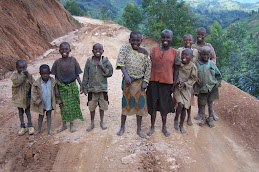Mar 12th
Off with Cathie to Kivumu primary, almost the last school in the district towards Kigali, so a nice long drive on good roads on motos. When we arrived the place looked far too small; brick buildings in an amazingly decrepit state with one section’s roof partially collapsed. Oh no, I thought, here we go again! Turns out that this is merely the annexe to Kivumu school, the overflow part in buildings rented from the church.
The school itself has 1700 pupils. That’s about as many as Beaminster and Colfox secondaries (or all their feeder primaries) put together! Its roll is growing, and Agnès will soon lose the classroom she has as her office. The buildings on the main site are almost all OK, and the Head teacher is one of our squad of head’s reps who came with me on the mass inspection back in February. Agnès is a smashing person – acute, jolly, interested and really, really nice to be with. Fortunately she’s obviously on the ball with all her documentation, so I’m able to give her a good write up in the Inspection Administratif” section. She’s got 30 teachers – that’s almost as many as at Beaminster secondary – and they all look so young! It’s like a student conference, or, rather, a group of young medics in their white coats! The children are amazing – imagine what it feels like to be mobbed by a thousand youngsters at break time, all standing round you in massed ranks staring at this phenomenon of two white people who’ve come to see them!
Cathie observes a couple of lessons and does a model lesson as usual; I observe one. Then - get this - while over a thousand children are good as gold and looked after by one auxiliary, we have our usual “pearls of wisdom” session with Agnès and the rest of the staff. They’re attentive listeners, and we’re beginning to feel more confident in what we’re going to say and what they can reasonably implement.
As at Bilingaga, this school has real problems with poverty. Many children don’t eat at mid day. There are 400 who are officially considered “enfants vulnerables” by Rwandan criteria. A nearby Franciscan church foundation feeds 36 each lunchtime, but it’s a drop in the ocean of need. Agnès tells us that last year one child, too ill to attend school, eventually died of acute malnutrition. Seems incredible in this day and age, and suddenly all the performance criteria and exam results targets get relegated to the background.
I don’t want to dwell on the unfortunate side of things – it’s a good school struggling in the face of all the usual problems; its staff are kind and humane. They just need a lot more training and the kind of intense, ongoing support which we could give if we were just looking after one sector of six or seven schools, but not when we have 106 primaries alone on our patch! Sometimes it makes you want to cry; you just feel so overwhelmed by the level of need that you don’t feel able to do anything.
It’s even worse when you consider that Rwanda is slowly coming out of the trough of appalling trauma at the end of the genocide. What on earth must this school have been like after 1994, with most of its teachers murdered, with none of its old 1950s mud-brick classrooms replaced, with no money, no organisation, no materials, no hope?
You just have to tell yourself that things are getting better, and the problems of overcrowding are due precisely to the amount of progress the country has made.
Best thing about today – being welcomed like old friends at this huge school.
Worst thing about today – discovering that even in 2008, in Rwanda, primary school children are dying of malnutrition.
By the way, I think there’s an even bigger school in Shyogwe secteur. And the Gihembe refugee camp school has about 4200 pupils, but that’s a special case….
Tuesday, 25 March 2008
Primary school or warehouse full of children?
Posted by
Bruce's Rwanda blog
at
10:18
![]()
Subscribe to:
Post Comments (Atom)















No comments:
Post a Comment